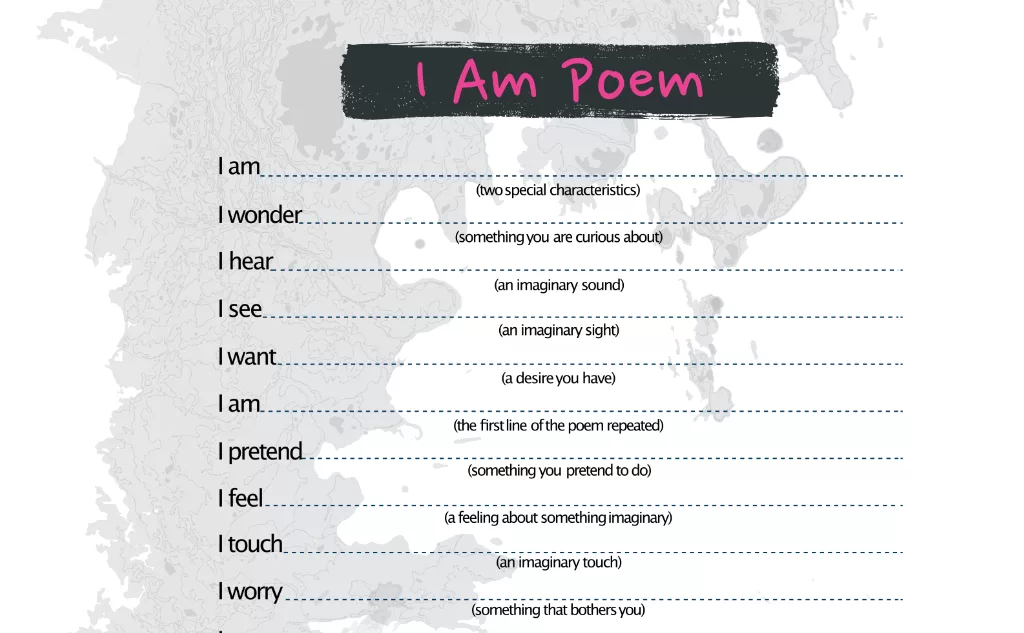I Am Poem

The "I Am" poem, a powerful and evocative form of self-expression, has been a staple of poetry and personal growth for decades. This type of poem, which originated from a teaching tool designed to help students express themselves, has evolved into a profound means of exploring one's identity, values, and experiences. By following a specific structure, individuals can craft a unique and revealing portrait of themselves, using the poem as a therapeutic and creative outlet.
Understanding the Structure of the “I Am” Poem

The traditional structure of the “I Am” poem involves a series of statements that begin with the phrase “I am,” followed by a descriptive word or phrase that reflects an aspect of the speaker’s personality, background, or emotions. This simple yet effective format allows individuals to delve into their inner world, acknowledging both their strengths and weaknesses, and to convey their authenticity in a concise and impactful manner. For instance, a person might start their poem with “I am strong,” “I am curious,” or “I am resilient,” setting the tone for a deeper exploration of their character.
Exploring Identity through the “I Am” Poem
One of the most significant benefits of writing an “I Am” poem is its ability to facilitate self-discovery and personal growth. By exploring various facets of their identity, individuals can gain a clearer understanding of who they are, what they value, and how they perceive the world around them. This process can be particularly empowering, as it encourages people to embrace their uniqueness and to celebrate their differences. For example, someone might express their cultural heritage by stating “I am the descendant of immigrants,” highlighting their connection to a broader community and acknowledging the influences that have shaped their life.
| Aspect of Identity | Example Statements |
|---|---|
| Personality Traits | I am adventurous, I am empathetic, I am determined |
| Experiences | I am a traveler, I am a learner, I am a survivor |
| Values and Beliefs | I am a believer in justice, I am a supporter of equality, I am a seeker of truth |

Key Points
- The "I Am" poem is a versatile tool for self-expression and personal growth, allowing individuals to explore their identity, values, and experiences in a creative and therapeutic manner.
- Its structure, based on statements beginning with "I am," provides a straightforward yet powerful framework for delving into one's character and acknowledging both strengths and weaknesses.
- Writing an "I Am" poem can facilitate self-discovery, encouraging individuals to embrace their uniqueness and celebrate their differences, while also providing a means to reflect on personal values and beliefs.
- The poem's impact extends beyond the individual, as it can serve as a bridge to understanding and empathy, allowing readers to connect with the poet on a deeper level and fostering a sense of community and shared human experience.
- Ultimately, the "I Am" poem stands as a testament to the complexity and beauty of human identity, inviting us to explore, express, and celebrate our authentic selves.
Creating Your Own “I Am” Poem

Embarking on the journey of creating an “I Am” poem can be a transformative experience, offering a unique opportunity for self-reflection and creative expression. To begin, individuals might consider brainstorming a list of words or phrases that resonate with their personality, experiences, and values. This could include aspects of their background, their passions, or their goals for the future. For example, someone might include “I am a dreamer,” “I am a friend,” or “I am a guardian of the environment,” each statement reflecting a different facet of their identity.
Guidelines for Crafting a Meaningful “I Am” Poem
While the structure of the “I Am” poem provides a clear framework, the true power of this form of poetry lies in its ability to capture the essence of the individual. To craft a meaningful “I Am” poem, it is essential to approach the process with sincerity and openness, allowing oneself to explore the depths of their emotions, beliefs, and experiences. This might involve experimenting with different words and phrases, seeking feedback from others, or revisiting and revising the poem over time. The goal is not to create a perfect poem but to express oneself authentically, using the “I Am” poem as a tool for personal growth and self-discovery.
What is the primary purpose of writing an "I Am" poem?
+The primary purpose of writing an "I Am" poem is to facilitate self-expression, personal growth, and self-discovery, providing a creative and therapeutic outlet for exploring one's identity, values, and experiences.
How can I make my "I Am" poem more impactful?
+To make your "I Am" poem more impactful, focus on sincerity and authenticity, using specific and personal details to bring your statements to life. Experiment with different structures and word choices, and consider sharing your poem with others to deepen your connection and foster empathy.
Can the "I Am" poem be used in therapeutic settings?
+Yes, the "I Am" poem can be a valuable tool in therapeutic settings, providing a safe and creative space for individuals to express their feelings, work through challenges, and develop a more positive and empowered sense of self.
In conclusion, the “I Am” poem stands as a powerful symbol of personal expression and growth, offering a unique lens through which we can explore our identities, values, and experiences. Through its creation and sharing, we not only deepen our understanding of ourselves but also connect with others on a profound level, fostering empathy, community, and a celebration of our shared humanity. As we continue to navigate the complexities of our lives, the “I Am” poem remains a timeless and versatile tool, inviting us to embrace our authenticity, to express our deepest truths, and to find strength in the simplicity and power of our own voices.



